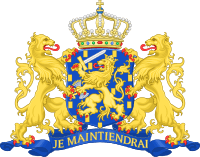Middle Class Party
The Middenstandspartij (in Dutch: Middenstandspartij, MP) was a Dutch political party representing middle class interests. It played only a marginal role in Dutch politics.
 |
|---|
| This article is part of a series on the politics and government of Netherlands |
|
|
Local government
|
|
Related topics |
Party History
The MP was founded by Abraham Staalman a businessman from Amsterdam. The 1918 elections were the first election in the Netherlands which used a system of proportional representation. With about 12500 votes (1% of the votes) the MP won one seat, as did several other one or two person parties. After the elections the election law became more restrictive. Between 1918 and 1921 the MP cooperated in the neutral parliamentary party, with four other one or two seat parties, namely the Peasants' League, the Economic League, the Neutral Party and the Alliance for Democratization of the Army. The parliamentary party was led by former minister Willem Treub. In 1921 several of these parties, including the Middle Class Party merged into the Liberal State Party, together with two larger liberal parties.
The Middle Class Party continued as an independent part of this new party, with a separate list for the elections (some times combined with the Neutral Party). In 1929 this special position was abolished and Staalman left the Liberal State Party to found the Middle Party for City and Country,[1] which won one seat in the 1929 elections. In 1971 the New Middle Party entered in the elections, which saw itself as a continuation of the Middle Class Party.
Ideology & Issues
The MP was a typical special interest party. Its main goal was to represent the interests of the middle class, those "stuck between the proletariat and capital". It advocated progressive taxation, reduced government interference and bureaucracy, recognition of employers' organizations and equal pension-rights for businessmen and workers.
Leadership & Support
This table show the MP's results in elections to the House of Representatives and Senate, as well as the party's political leadership: the fractievoorzitter, is the chair of the parliamentary party and the lijsttrekker is the party's top candidate in the general election, these posts are normally taken by the party's leader.
| Year | HoR | S | Lijsttrekker | Fractievoorzitter |
|---|---|---|---|---|
| 1918 | 1 | 0 | Abraham Staalman | Abraham Staalman |
| 1919 | 1 | 0 | no elections | Abraham Staalman |
| 1920 | 1 | 0 | no elections | Abraham Staalman |
Electorate
The party drew most of its support from Amsterdam, where Abraham Staal was a well-known figure. The party also had a seat in the city's municipal council.
References
- Vossen, Koen, Vrij Vissen in het Vondelpark. Kleine politieke partijen in Nederland 1918-1940, Wereldbibliotheek, Amsterdam